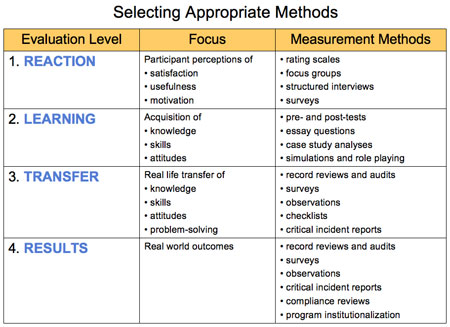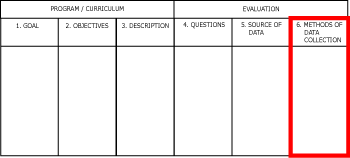
Matching Outcomes and Measurement Methods
Outcomes can be measured using a variety of methods, depending on the source of the information, the resources available for implementing the evaluation and the time frame for documenting results.
Some methods are more appropriate depending on the kinds of data being collected. The table below summarizes types of outcomes and methods of measurement often associated with them. This table was created by the authors of this tutorial, who based it on ideas from Kirkpatrick & Kirkpatrick, 2006.

EXAMPLE
Our sources of data about communication skills training are the students, faculty and standardized patients. Now we have to decide how we will gather these data.
To gather data from students we will use a web-based questionnaires and reflective paper. To gather data from faculty and standardized patients will provide ratings of student performance using standardized rating forms.
See Example 1 in the Resources menu at the right for this example evaluation plan completed thus far.
WRITE YOUR OWN METHODS OF DATA COLLECTION
In your Evaluation Planning Tool enter your methods of data collection in column 6.
Do you need more information? Check out the RESOURCES menu at the right.

Next Steps
You have now finished this evaluation tutorial and may be wondering, "What do I do next?"
One suggestion is to review and refine your evaluation planning tool and consider using it as a supportive graphic to include in your program documentation. It is an effective way to succinctly describe the relationship between your proposed program's goals and objectives and the plan for evaluation. When we use similar tools in our own evaluation planning we often discover gaps or mismatches between our evaluation methods and our program objectives.
Good luck!